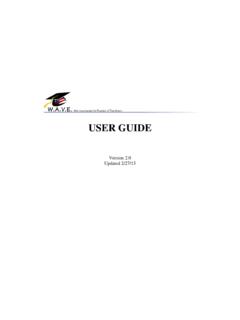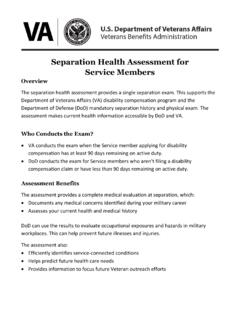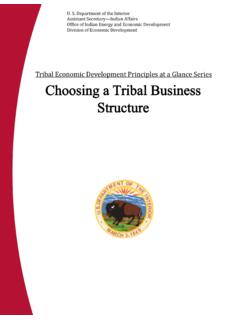Transcription of Building Your Future With the GI Bill - Veterans Affairs
1 OCTOBER 2020 Building Your Future With the GI bill PART ONE: A GUIDE TO choosing YOUR EDUCATION PATHWAY2 Building YOUR Future WITH THE GI BILLThe Department of Veteran Affairs (VA) offers education benefits to eligible service members, Veterans and their families to further their education and advance their careers. Earning a degree or obtaining advanced occupational training can open doors and lead to boundless opportunities. Utilizing your benefits to be more competitive in the workforce can help to attain a higher salary and job stability, and boost employer-provided benefits. This guide, part one in a three-part series, is meant to assist Future GI bill beneficiaries, like you, in navigating education of ContentsGet 3 Skills and 3 Career 3 Choose Your Education 4 Types of 4 Types of 5 Types of 6 Next 6 On Campus 73A GUIDE TO choosing YOUR EDUCATION PATHWAYWhat is your purpose for furthering your education? Do you know what you want to study or what type of career you want to pursue?
2 You may not have the answer now, but as a GI bill beneficiary, you have a wide array of options and opportunities to pursue your education goals, and numerous resources available to assist you. As a first step, you should acknowledge your skills and interests and how they may translate into a Future AND INTERESTSUse CareerScope , a free self-assessment tool, to determine your vocational aptitudes and academic readiness. It provides an assessment of your interests and talents, gives recommendations about which careers you may enjoy and helps you decide which courses or training programs you should focus on to pursue those GOALSFor most students, the purpose of earning a degree or completing a training course is to start a new career or to advance their current career. It is important to determine your end goal in order to get the most out of your education benefits. By choosing a prospective career, you can plan backwards to determine which school or program is the best choice to pursue this goal.
3 If you are a service member or Veteran, learn how your military training can translate into a civilian job using various Military Occupation Specialty (MOS) skills matching tools where you are able to input your MOS to see what career types align with your military Started4 Building YOUR Future WITH THE GI BILLCERTIFICATE Certificates verify that a student has completed specific training courses relevant to a particular job or industry. Training can last a few weeks to several months, based on the This degree generally requires 60 credit hours of training and two years of full-time attendance. After receiving an associate degree, you can seek employment or transfer into a four-year program to work towards earning a bachelor s degree. Traditional degrees offered are Associate s of Arts ( ) and Associate s of Science ( ).BACHELOR S Obtained at a college or university, with degree programs that usually last four years. This degree generally requires 120 credit hours of training and four years of full-time attendance.
4 Required if you plan to earn a graduate or professional degree. The primary degrees are Bachelor s of Arts ( ) and Bachelor s of Science ( ).MASTER S/POSTGRAD Universities offer intensive one to two-year graduate programs to pursue a master s degree. Most programs offer full-time and part-time options. Courses are designed to provide a more in-depth approach to your desired discipline after completing a bachelor s The highest academic degree in a field of study. This degree takes three to six years to complete. Typically, you must complete your bachelor s and master s degrees before obtaining a doctoral degree. Degree types include , Law degree ( ), and Medical degrees ( and ).Choose Your Education PathwayThere are several different types of degrees and types of schools to consider. It is important to keep in mind the length of time and amount of education benefits you may expend when choosing your degree track and school type. Below you will find lists of degrees and : In some industries, you can begin your career at different levels of responsibility and compensation based on which degree-type you earn.
5 Information technology, nursing, veterinary, and other careers can all begin with a certificate or an associate, bachelor s, master s and/or doctorate of Degrees5A GUIDE TO choosing YOUR EDUCATION PATHWAYCOMMUNITY COLLEGE Community colleges primarily offer two-year associate degrees (with some exceptions). To complete undergraduate studies and earn a bachelor s degree, you may decide to attend a community college and then transfer to a local public university. These community colleges are called feeder schools and develop agreements with four-year colleges to recognize the credits earned toward degree programs. The associate degree you will earn at community college may cover your freshman and sophomore credits. Take a look at the College Partnerships and Articulate Agreement to see what schools in your state have these agreements. Many students choose this route because they earn credits at a significantly lower cost while preparing academically to attend a four-year program.
6 COLLEGE/UNIVERSITY Colleges and universities offer a variety of both undergraduate (associate and bachelor s) and graduate degree (master s and doctorate) programs. This is further broken down by the following school types: Public: State-funded institutions of higher education that include community colleges and universities. Under the Post-9/11 GI bill , students are eligible to have all charged tuition and fees for in-state students paid to the school. Private non-profit: Primarily funded through a combination of tuition and fee charges and funding raised. Under the Post-9/11 GI bill , students are eligible to receive up to a national maximum dollar amount paid to the school for tuition and fees and may be eligible to participate in VA s Yellow Ribbon Program*. Private for-profit: Education institutions operated by profit-seeking businesses and funded through tuition and fee charges. Under the Post-9/11 GI bill , students are eligible to receive up to a national maximum dollar amount paid to the school for tuition and fees and may be eligible to participate in VA s Yellow Ribbon Program*.
7 The Rogers STEM Scholarship can provide nine months (up to $30,000) of additional Post-9/11 GI bill benefits to qualifying Veterans training in high demand STEM (Science, Technology, Engineering, and Math) fields who have exhausted or are about to exhaust their entitlement.* The Yellow Ribbon Program can help you pay for higher out of state, private school or graduate school tuition that the Post-9/11 GI bill does not cover. You will need to find out if you qualify and if the school you are interested in participates in the program. TECHNICAL/TRADE SCHOOLS Technical/trade schools are post-secondary institutions that provide a student with a technical skill or trade to prepare them for a specific occupation; electrician, plumber, welder, software coder, IT specialist, mechanic, construction specialist, heavy machine operator, commercial diving, etc. Trade schools provide instruction varying from a few months to a few years, depending on follow-on training. Veteran Employment Through Technology Education Courses (VET TEC) and VA s On-The-Job Training and Apprenticeship Program provide additional education benefits options for programs with approved providers that lead to employment upon completion of the of Schools6 Building YOUR Future WITH THE GI BILLIN-PERSON, FULL-TIME Attending full credit-hour schedule of courses , PART-TIME Attending courses on-campus on a partial credit-hour course schedule.
8 Provides flexibility for students with busy schedules or Students complete courses online. Provides flexibility for schedules and not Students learn with a combination of in-person classes and online : VA education benefits rates differ by school, program, degree-type, and learning track. You can check payment rates on VA education benefits rates differ by school, program, degree-type, and learning track. You can check payment rates on VA s Education & Training Rate Tables and compare individual schools on the GI bill Comparison of Learning Do the research What schools offer the best program for your career track? Where does your desired company or industry recruit from? Many schools offer similar majors, such as business, engineering, arts, health care, etc., but some programs have a better reputation or facilities that make their graduates more desirable in the job market. Conversely, some programs are unique and can only be found at particular schools or universities.
9 Take time to review the school s reputations, program characteristics, major options and other requirements. Use the GI bill Comparison Tool Learn about education programs and compare benefits by school to determine which one is the best fit for you. Use the Department of Education s College Scorecard Find statistics on schools graduation rates, average income after graduation, acceptance rates, fields of study and more using the College Scorecard. Visit the school Attend an open house or take a tour of the school. Visits can provide information on specific programs, relevant scholarships and the application process, as well as give you a glimpse of the campus life. During your visit, you may have the opportunity to meet with students, faculty and fellow members of the military-connected community to hear their experiences. Network with alumni Speak with graduates, students and fellow Veterans who attended or who are currently enrolled in the school to hear their first-hand experiences with the institution and the student StepsWith your interests in mind and an understanding of the education paths available, you can begin to research potential schools or programs.
10 You do not need to have complete certainty during this phase, but it is helpful to have a clear, achievable goal in mind. Here are some next steps to take as you move forward in your education GUIDE TO choosing YOUR EDUCATION PATHWAYOn Campus ResourcesSome schools provide resources specifically for Veterans and family members to provide support during the transition and keep you on track during your education journey. Important resources to consider include: Veteran Resource Centers Many schools have offices designed to enhance your educational experience as a Veteran. Take a look at the GI bill Comparison Tool to see if your prospective school offers this type of assistance. Consider using the Personalized Career Planning Guidance (PCPG) Program to enhance your educational experience and choose the right program to meet your education and career Veterans of America (SVA) This organization provides valuable connections for Veterans and helps foster a sense of community at the school, giving Veterans a voice in their respective school administration.















